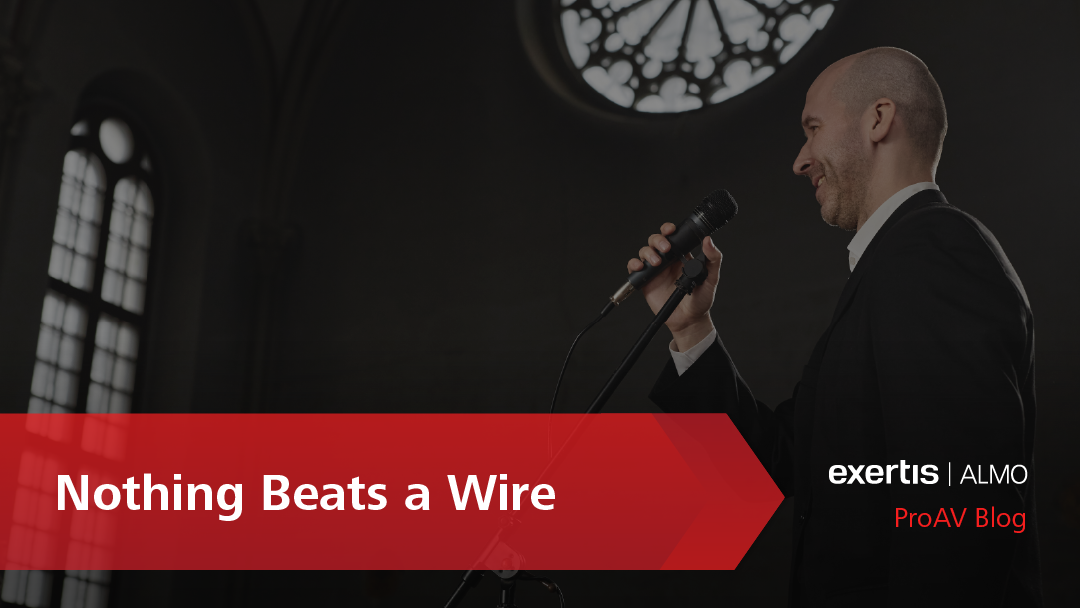“The new pastor would like to have hardwired microphones instead of wireless for the following locations…”
What a refreshing request: hardwired microphones. Yes, I’m aware that wireless cleans up the stage and wireless certainly looks better on camera, especially since so many churches are now streaming their services each week.
But do I really need a wireless for a lectern or pulpit? Or for a vocalist on a piano or even the vocal for a guitar player who’s not moving around?
 I’ve even seen an increase in requests for wireless for city council chambers. Read that again. For a city council. They sit behind a council table. Your typical local council is probably well known for being intractable and immovable so I can’t fathom the need for a wireless in that application. Hardwired mics only.
I’ve even seen an increase in requests for wireless for city council chambers. Read that again. For a city council. They sit behind a council table. Your typical local council is probably well known for being intractable and immovable so I can’t fathom the need for a wireless in that application. Hardwired mics only.
Remember when our UHF wireless microphones had to vacate the 600 MHz spectrum not all that long ago? You couldn’t simply tune to a new frequency, you had to replace the entire system. Plus, there’s the cost and maintenance of batteries. If you’re using rechargeable batteries, you need to make sure the transmitters are placed back in the charging station after use. And when those batteries no longer hold a charge, there’s proper disposal issues and you need to purchase new batteries. The more things the end user has to remember, the more they may be overlooked.
If you’re using UHF wireless, you need a frequency band that works in your specific area, and you need to coordinate frequencies with the other UHF wireless units that you have (microphones, IEMs, intercom). If you have multiple receivers, you’re looking at antenna distribution, remote antennas, coax runs, etc. If you’re using DECT at 1.9 GHz or using 2.4 GHz, there’s the possibility of interference from other unlicensed devices.
What maintenance is required with a hardwired microphone? I’ll wait….
The late Ray Rayburn is famous for saying, “A wireless microphone is just a very expensive replacement for a 25 ft. mic cable.”
If you’re using quality mic cable and name-brand XLR connectors and wrap your cables properly, a good mic cable will last decades on stage. A few years ago, I was assisting a friend on a gig outside of Nashville and did a double take when I saw the same mic cables that I had soldered together and labeled almost three decades ago. How did I know these were my original cables? By the brand of cable and connectors used, and by the wire markers from my Ideal wire marker booklet that I saw under the clear heat shrink. The cables still had my RipTie cable wraps! He was now the third owner of these cables. Wow.
As far as mic cables, you might as well make your own. Even if you buy a quality premade, you still need to pull the connector off one end so you can label them. Use a numbering scheme that combines cable identification with length so you don’t have to chase cables on stage. Secure those cable IDs under clear heat shrink and finish the job with a permanent cable tie on the male end of each XLR cable. (You do know how to solder, don’t you?)
Consider also what you’re either getting or giving up, in the choice of hardwired or wireless. For the price of a lower-cost wireless system, you can buy a magnificent-sounding hardwired microphone.
Something that I think has been lost with the increase in less expensive wireless microphones: sound quality. While those with real budgets can afford a higher-end wireless sporting a high-quality mic capsule on top, everyone else has been settling for what I would consider lower-end capsules just for the supposed convenience of going wireless.
I think it’s time we rediscover the joy of listening to a really good wired microphone.
Excellent microphones and labeled quality cables will be some of your most reliable friends ever and it will never need batteries.
THE EXCEPTION
 There is only one absolute rule when not to use a hardwired microphone: the baptistry. Never, ever place a hardwired microphone within reach of a baptistry. In the mid-2000s, Reverend Kyle Lake of University Baptist Church in Waco, TX was electrocuted as his hand made contact with a hardwired microphone connected to the church’s audio system. It wasn’t the fault of the correctly installed audio system or phantom power, it was a short circuit that had developed in the baptismal water heater. The investigation revealed that the older water heater wasn’t up to current electrical codes and it lacked a ground wire. When Reverend Lake touched the microphone, he became an inadvertent electrical path as the electricity sought a way to return to its source. If you need a wireless, the baptistry is the perfect application.
There is only one absolute rule when not to use a hardwired microphone: the baptistry. Never, ever place a hardwired microphone within reach of a baptistry. In the mid-2000s, Reverend Kyle Lake of University Baptist Church in Waco, TX was electrocuted as his hand made contact with a hardwired microphone connected to the church’s audio system. It wasn’t the fault of the correctly installed audio system or phantom power, it was a short circuit that had developed in the baptismal water heater. The investigation revealed that the older water heater wasn’t up to current electrical codes and it lacked a ground wire. When Reverend Lake touched the microphone, he became an inadvertent electrical path as the electricity sought a way to return to its source. If you need a wireless, the baptistry is the perfect application.
If you need help selecting the right magnificent hardwired (or wireless) mic for your application, let us know here at Exertis Almo. We would love to help you rediscover the wonderful sound of a wire.










